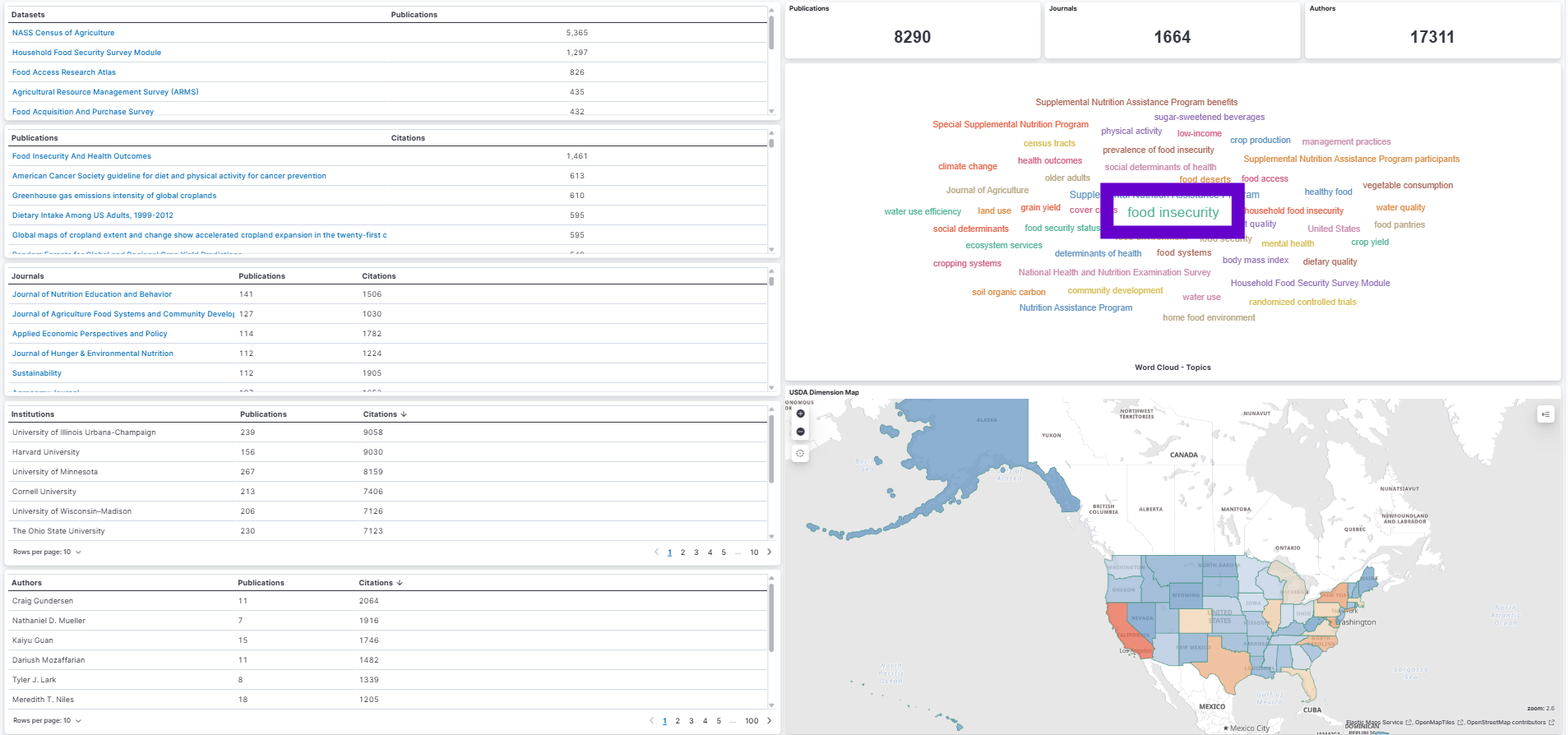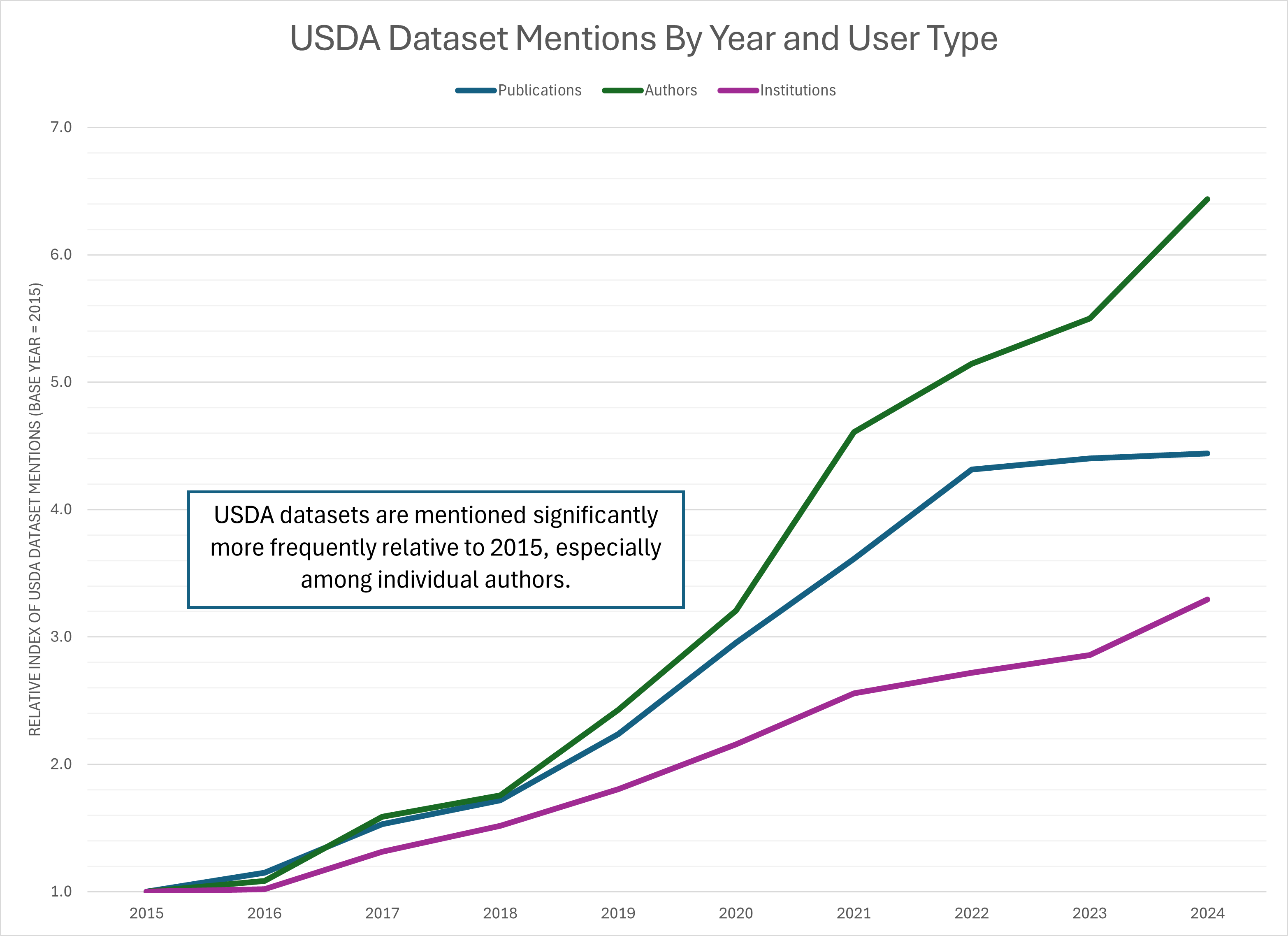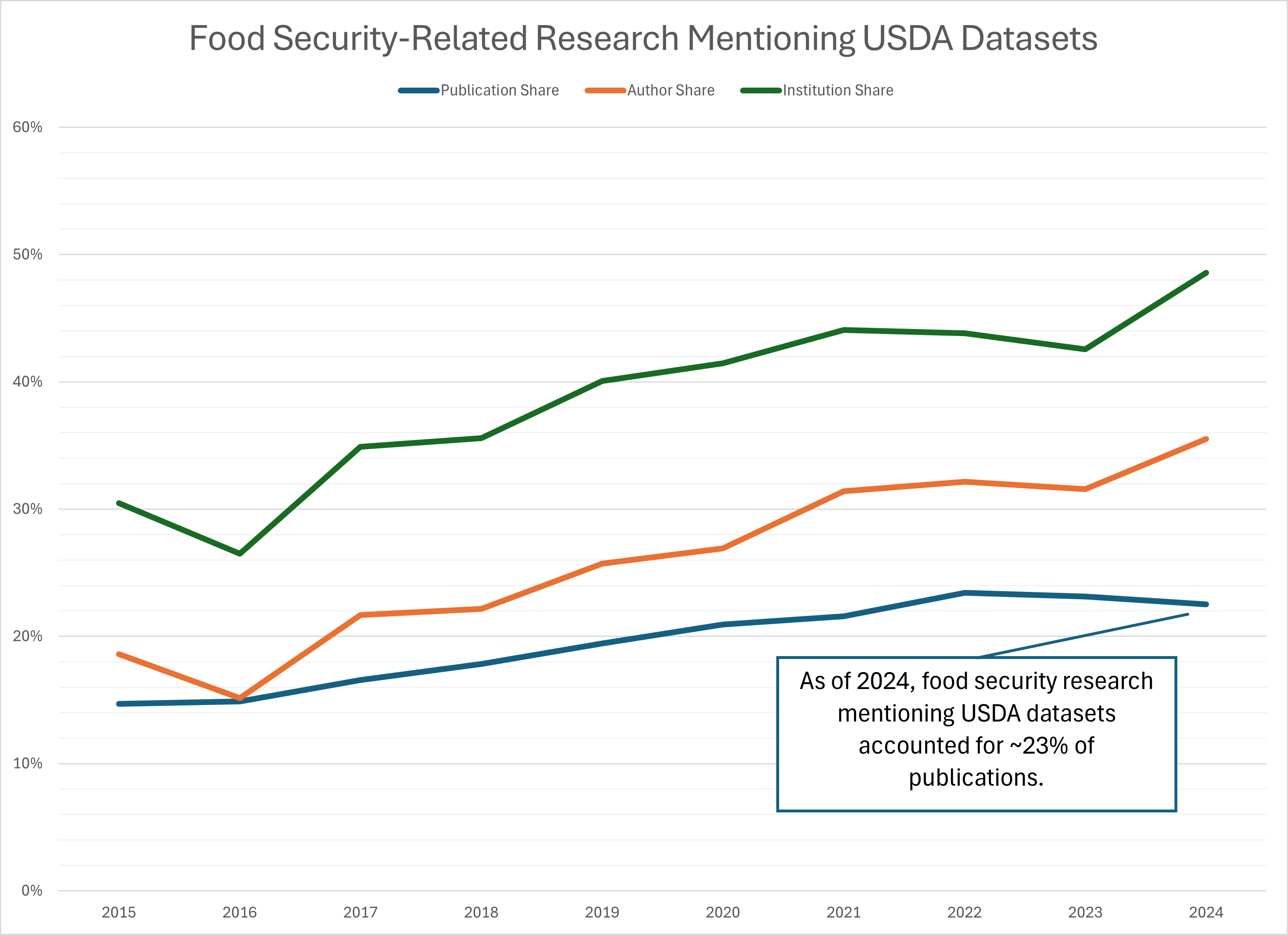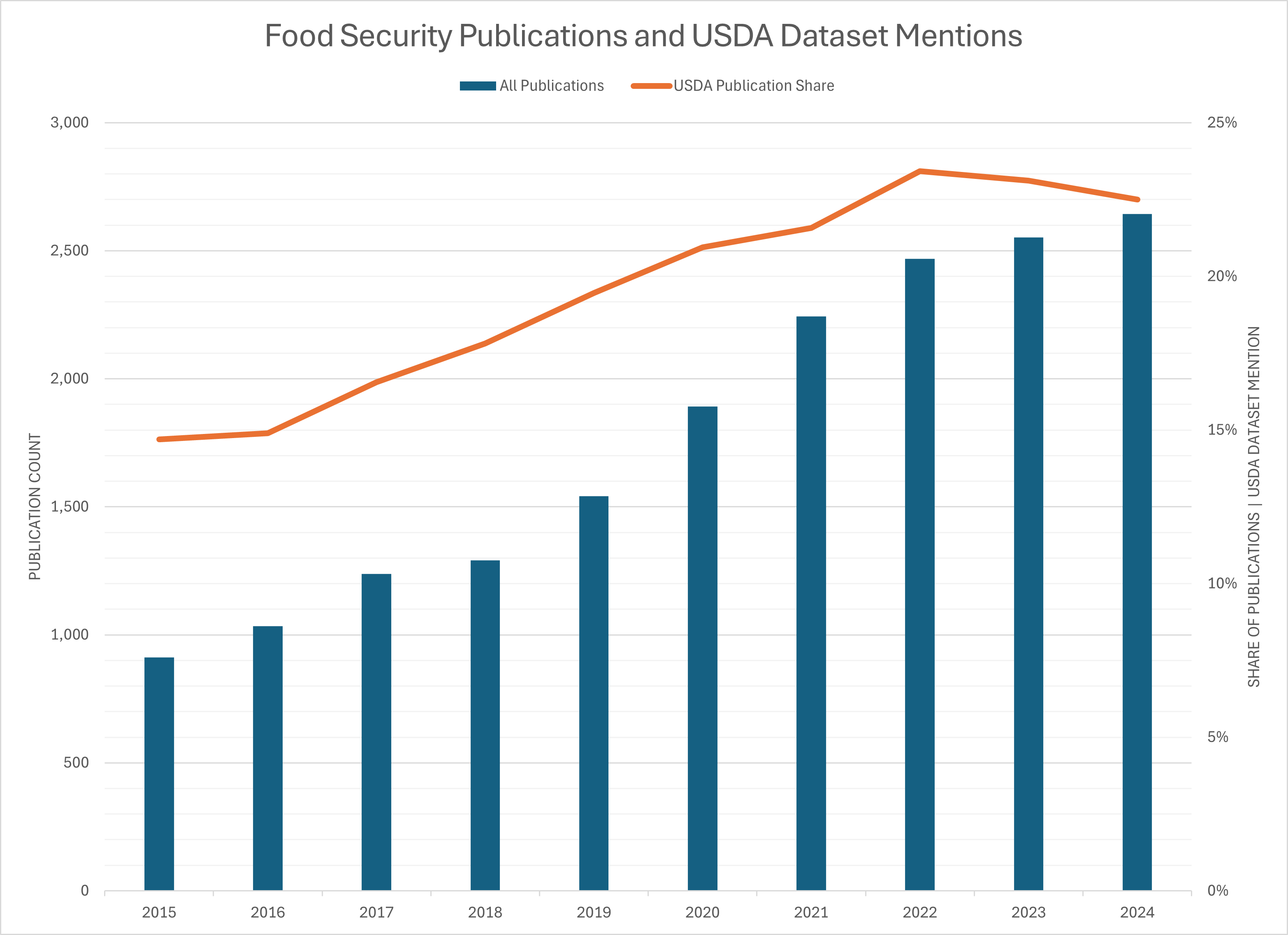Dataset Search & Discovery
Initial findings & opportunities to collaborate
AAEA 2025 — Denver, Colorado
July 27, 2025
Setting
Over the past several months, I’ve been working on a project that looks at
how USDA datasets are mentioned in research publications.
In the following slides, I’d like to share some of these initial findings and ask:
What would be useful for AAEA section members?
Possible questions to reflect on as you’re listening
- What can metadata on topic trends tell us about research in your section’s area of focus?
- Could this type of platform help identify potential collaborators or build working groups?
- Are there emerging research topics that could inform next year’s track session proposals?
- What can metadata on funding tell us about who is supporting research in your section’s area of focus?
Why USDA data?
USDA ERS and NASS were interested in tracking how their datasets are referenced in research papers.
Two dashboards that track mentions* of 11 key datasets in articles were built.
This helps:
- Summarize dataset usage over time
- Identify where and in what topics USDA data shows up
- Highlight research across areas like food security, crop production, and others…
These 11 datasets were selected based on relevance and input from USDA staff and researchers.
*A dataset mention refers to an instance in which a specific dataset is referenced, cited, or named within a research publication. This can occur in various parts of the text, such as the abstract, methods, data section, footnotes, or references, and typically indicates that the dataset was used, analyzed, or discussed in the study.
Details about this exercise
Datasets searched:
- Agricultural Resource Management Survey (ARMS)
- Current Population Survey Food Security Supplement
- Farm to School Census
- Information Resources, Inc. (IRI) InfoScan (through USDA TPAA)
- NASS Census of Agriculture
- Tenure, ownership, and transition of agricultural land (TOTAL) survey
- Food Access Research Atlas
- Food Acquisition and Purchase Survey
- Household Food Security Survey Module
- Local Food Marketing Practices Survey
- Quarterly Food at Home Price Database
Searched articles published between 2015-2025.
Mentions of datasets can be found in publications by applying ML models and other methods.
Data source: Dimensions via Google BigQuery
References:
Read more about this project here.
Who uses USDA data…
We searched a large publication corpus (Dimensions) to find mentions of 11 USDA datasets and found that 17,311 authors mentioned these datasets across 8,290 publications in 1,664 journals.

Work was funded by the US Department of Agricultural (Economic Research Service and National Agricultural Statistics Service), the National Center for Science and Engineering Statistics, and the National Center for Education Statistics.
…and how?
Food insecurity is one of the most frequently occurring topics among publications mentioning selected USDA datasets across all journals.
 The word cloud shows the frequency of associated topics — larger words indicate more publications on that topic.
The word cloud shows the frequency of associated topics — larger words indicate more publications on that topic.
Access the Democratizing Data FAR Data Dashboard here.
Use case: What can we observe from a focused topic area?
To better understand how USDA datasets are used, we examined one area in more detail: food security–related research.*
This example will show:
The extent to which selected USDA datasets are mentioned within a topic area over time
The share of food security-related research that explicitly mentions these datasets
How USDA dataset usage has changed over time relative to all published work in this area
*Food security-related research includes articles with topics such as: “food security,” “SNAP,” “WIC,” “food access,” “food availability,” “food insecurity prevalence,” and “Nutrition Assistance Program.”
Mentions of selected USDA datasets have grown over time in food security–related research.
- Mentions in publications have grown, but pace has leveled off slightly in recent years
- Authors mentioning datasets have grown more than 6x, suggesting strong interest across the research community
- Institutions mentioning datasets has grown slowly, perhaps due to potential concentration within organizations
Details about this figure
This figure plots an index of unique publications, authors, or institutions mentioning the selected USDA datasets from 2015-2024, where 2015 is the base year (index = 1). For example, there were 595 publications in 2024 and 134 in 2015, so the index is 595 / 134 = 4.44.
Terms used to define food security research include: “food security”, “food insecurity”, “food security status”, “Supplemental Nutrition Assistance Program (SNAP)”, “Special Supplemental Nutrition Program for Women, Infants, and Children (WIC)”, “food access”, “food availability”, “prevalence of food insecurity”, “food pantries”, and “Nutrition Assistance Program”.
Data source: Dimensions via Google BigQuery
Publications mentioning selected USDA datasets account for 21% of all food security-related publications.
This implies that 79% of food security-related research uses other datasets (or doesn’t name the data at all).
That might not raise concern if mentions of USDA datasets were declining in line with overall trends in food security research.
But as we’ll see next, the volume of food security publications continues to grow while USDA dataset mentions have plateaued.
Details about this figure
This figure compares:
- Denominator: All publications in the Dimensions database (via Google BigQuery) that mention food security–related terms, published between 2015 and 2024, excluding preprints and conditional on at least one US-affiliated author and falling within the fields of research “3801 Applied economics” or “30 AGRICULTURAL, VETERINARY AND FOOD SCIENCES”.
- Numerator: The subset of those publications that also mention one or more of the 11 USDA datasets.
Terms used to define food security research include: “food security”, “food insecurity”, “food security status”, “Supplemental Nutrition Assistance Program (SNAP)”, “Special Supplemental Nutrition Program for Women, Infants, and Children (WIC)”, “food access”, “food availability”, “prevalence of food insecurity”, “food pantries”, and “Nutrition Assistance Program”.
Data source: Dimensions via Google BigQuery
Mentions of selected USDA datasets are leveling off as food security-related research continues to grow.
Next question: What other datasets are researchers using for food security-related research?
\(\rightarrow\) Answering this requires access to full-text data and LLMs trained to identify dataset usage.
Currently working on this.
Details about this figure
This figure shows two trends in food security–related research from 2015 to 2024:
- Bars (left axis): Total number of food security–related publications per year across the Dimensions corpus. These publications have been filtered to include only those with at least one author affiliated with an American institution and falling within the fields of research “3801 Applied economics” or “30 AGRICULTURAL, VETERINARY AND FOOD SCIENCES”.
- Line (right axis): Share of those publications that mention one or more USDA datasets.
Terms used to define food security research include: “food security”, “food insecurity”, “food security status”, “Supplemental Nutrition Assistance Program (SNAP)”, “Special Supplemental Nutrition Program for Women, Infants, and Children (WIC)”, “food access”, “food availability”, “prevalence of food insecurity”, “food pantries”, and “Nutrition Assistance Program”.
Data source: Dimensions via Google BigQuery
What I’ve learned
We can only track what we can see. If authors are not writing about the datasets they use we won’t see it. Most authors don’t cite their data.
As an author, I find myself wanting better tools to find comparable studies using the same dataset – being able to search within publications that share a dataset is useful.
Publication metadata contains rich, underused information (e.g., open access, funders, citations, article processing charges) – available from OpenAlexAPI or by partnering with Digital Science (Dimensions).
At this stage, there’s a lot more we could do — but we would need resources and interested collaborators.
Reflecting on value to AAEA Sections
Questions to consider
- What can metadata on topic trends tell us about research in your section’s area of focus?
- Could this type of platform help identify potential collaborators or build working groups?
- Are there emerging research topics that could inform next year’s track session proposals?
- What can metadata on funding tell us about who is supporting research in your section’s area of focus?
For you:
Use dashboard to find collaborators and review broad data usage statistics.
With access to the publication metadata, additional trends on topics of interest can be explored further.
For our research community:
- If we can identify the “other” datasets (via LLMs, for example), we can also identify the researchers using them and potentially build networks of topic experts, reviewers, and collaborators around them.
Final thoughts
- How might AAEA Sections use this dashboard?
- Track session proposals
- Pre/post conference workshop ideas
- Collaborators for working groups outside of meetings
- Aside from food security, what other topics may be of interest to understand data visibility?
- Specialty crops
- Food safety
- Food marketing
Example: Specialty Crops (S-1088)
- Use dashboard metadata to explore funding trends on specialty crop research
- Hatch renewal comment: “Expand members” → dashboard can help!
- Meeting idea: live demo + brainstorming researchable questions
Thank You
💬 Questions?
📩 Lauren.Chenarides@colostate.edu
🌐 democratizingdata.ai

Acknowledgements:
- Julia Lane
- Rafael Ladislau
- Nick Pallotta
- Spiro Stefanou
Back to All Talks.


